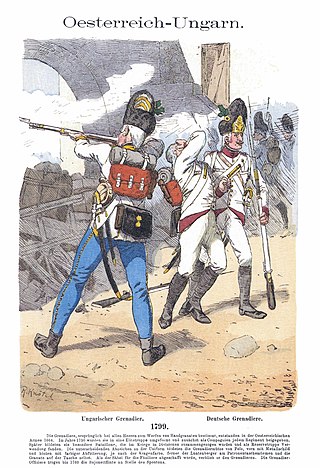
The War of the Polish Succession was a major European conflict sparked by a civil war in the Polish–Lithuanian Commonwealth over the succession to Augustus II the Strong, which the other European powers widened in pursuit of their own national interests. France and Spain, the two Bourbon powers, tested the power of the Austrian Habsburgs in Western Europe, as did the Kingdom of Prussia, whilst Saxony and Russia mobilized to support the eventual victor. The fighting in Poland–Lithuania resulted in the accession of Augustus III, who in addition to Russia and Saxony, was politically supported by the Habsburgs.

The War of the Austrian Succession was a European conflict fought between 1740 and 1748, primarily in Central Europe, the Austrian Netherlands, Italy, the Atlantic Ocean and Mediterranean Sea. Related conflicts include King George's War in North America, the War of Jenkins' Ear, the First Carnatic War, and the First and Second Silesian Wars.

The Battle of Fontenoy took place on 11 May 1745 during the War of the Austrian Succession, near Tournai, then part of the Austrian Netherlands, now in Belgium. A French army of 50,000 under Marshal Saxe defeated a Pragmatic Army of roughly the same size, led by the Duke of Cumberland.

The final battles of the European theatre of World War II continued after the definitive surrender of Nazi Germany to the Allies, signed by Field marshal Wilhelm Keitel on 8 May 1945 in Karlshorst, Berlin. After German leader Adolf Hitler's suicide and handing over of power to grand admiral Karl Dönitz in May 1945, Soviet troops conquered Berlin and accepted surrender of the Dönitz-led government. The last battles were fought on the Eastern Front which ended in the total surrender of all of Nazi Germany’s remaining armed forces such as in the Courland Pocket in western Latvia from Army Group Courland in the Baltics surrendering on 10 May 1945 and in Czechoslovakia during the Prague offensive on 11 May 1945.

The Western Front was a military theatre of World War II encompassing Denmark, Norway, Luxembourg, Belgium, the Netherlands, the United Kingdom, France, and Germany. The Italian front is considered a separate but related theatre. The Western Front's 1944–1945 phase was officially deemed the European Theater by the United States, whereas Italy fell under the Mediterranean Theater along with North Africa. The Western Front was marked by two phases of large-scale combat operations. The first phase saw the capitulation of Luxembourg, Netherlands, Belgium, and France during May and June 1940 after their defeat in the Low Countries and the northern half of France, and continued into an air war between Germany and Britain that climaxed with the Battle of Britain. The second phase consisted of large-scale ground combat, which began in June 1944 with the Allied landings in Normandy and continued until the defeat of Germany in May 1945 with its invasion.

The 1748 Treaty of Aix-la-Chapelle, sometimes called the Treaty of Aachen, ended the War of the Austrian Succession, following a congress assembled on 24 April 1748 at the Free Imperial City of Aachen.

The Italian campaigns of the French Revolutionary Wars (1792–1801) were a series of conflicts fought principally in Northern Italy between the French Revolutionary Army and a Coalition of Austria, Russia, Piedmont-Sardinia, and a number of other Italian states.

The Battle of Rocoux took place on 11 October 1746 during the War of the Austrian Succession, at Rocourt, near Liège in the Prince-Bishopric of Liège, now modern Belgium. It was fought between a French army under Marshal Saxe and a combined British, Dutch, German and Austrian force led by Charles of Lorraine, John Ligonier and Prince Waldeck.

The Battle of Lauffeld, variously known as Lafelt, Laffeld, Lawfeld, Lawfeldt, Maastricht, or Val, took place on 2 July 1747, between Tongeren in modern Belgium, and the Dutch city of Maastricht. Part of the War of the Austrian Succession, a French army of 80,000 under Marshal Saxe defeated a Pragmatic Army of 120,000, led by the Duke of Cumberland.

The Balkans theatre or Balkan campaign was a theatre of World War I fought between the Central Powers and the Allies.

The Allied Control Council (ACC) or Allied Control Authority, and also referred to as the Four Powers, was the governing body of the Allied occupation zones in Germany (1945–1949/1991) and Austria (1945–1955) after the end of World War II in Europe. After the defeat of the Nazis, Germany and Austria were occupied as two different areas, both by the same four Allies. Both were later divided into four zones by the 1 August 1945 Potsdam Agreement. Its members were the Soviet Union, the United Kingdom, the United States, and France. The organisation was based in Schöneberg, Berlin.

The siege of Bergen op Zoom took place during the Austrian War of Succession, when a French army, under the command of Count Löwendal and the overall direction of Marshal Maurice de Saxe, laid siege and captured the strategic Dutch border fortress of Bergen op Zoom on the border of Brabant and Zeeland in 1747. The fortress was defended by Dutch, Austrians, British, Hanoverians and Hessians that supported the Pragmatic Sanction.
Arthur Villettes was a British diplomat who played an important role in diplomatic negotiations of the 18th century often serving as an envoy of the long-standing controller of British foreign policy the Duke of Newcastle. This reached a height during the War of the Austrian Succession when he served as the British Resident in Sardinia, and was given enormous discretion over negotiations with Britain's Allies and opponents until he caused serious offence to Austria following the Siege of Genoa in 1746.
The siege of Genoa took place in 1747 when an Austrian army under the command of Count Schulenburg-Oeynhausen launched a failed attempt to capture the capital of the Republic of Genoa.

The siege of Brussels took place between January and February 1746 during the War of the Austrian Succession. A French army under the overall command of Maurice de Saxe, in a bold and innovative winter campaign besieged and captured the city of Brussels, which was then the capital of the Austrian Netherlands, from its Austrian garrison.
The foreign alliances of France have a long and complex history spanning more than a millennium. One traditional characteristic of the French diplomacy of alliances has been the "Alliance de revers", aiming at allying with countries situated on the opposite side or "in the back" of an adversary, in order to open a second front encircling the adversary and thus re-establish a balance of power. Another has been the alliance with local populations, against other European colonial powers.

The Raid on Genoa was a minor naval engagement fought in the harbour of the Italian city of Genoa during the first year of the French Revolutionary Wars. French Republican forces in the Mediterranean, under pressure from Austrian and Spanish armies, Royalist uprisings and British blockade had suffered the loss of their principal naval base and the fleet stationed there when British forces under Lord Hood seized Toulon at the invitation of the city's Royalist faction. The survivors of the French fleet were scattered across the Mediterranean, several sheltering in neutral Italian harbours, including the frigates Modeste at Genoa and Impérieuse at Leghorn.

The First Battle of Marengo or Battle of San Giuliano saw Republican French soldiers under General of Division Jean Victor Marie Moreau launch a reconnaissance in force against a larger force of Habsburg Austrian and Imperial Russian troops led by Field Marshal Alexander Suvorov. The French enjoyed initial success, pressing back their opponents. However, large Austrian and Russian reinforcements soon arrived, causing the French to withdraw into Alessandria. This War of the Second Coalition meeting engagement occurred near the town of Spinetta Marengo, located just east of Alessandria in northwest Italy.

The Convention of Alessandria was an armistice signed on 15 June 1800 between the French First Republic led by Napoleon and Austria during the War of the Second Coalition. Following the Austrian defeat at the Battle of Marengo, they agreed to evacuate Italy as far as the Mincio and abandon strongholds in Piedmont and Milan. Great Britain and Austria were allies and hoped to negotiate a peace treaty with France, but Napoleon insisted on separate treaties with each nation. The negotiations failed, and fighting resumed on 22 November 1800.

The siege of Antibes took place in the winter of 1746–47, during the War of the Austrian Succession. A combined Austro-Savoyard army, commanded by Maximilian Ulysses Browne, invaded France and laid siege to Antibes on the French Mediterranean coast. Despite having British naval support, the Allies failed to capture the town, and after two months Browne's army was forced to lift the siege and retreat back over the border into Savoy.


















